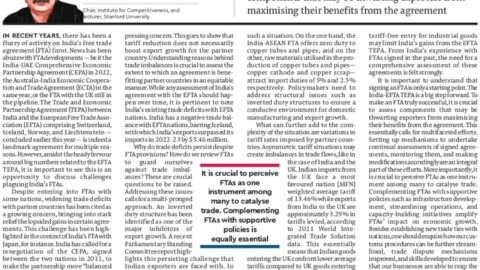Leveraging AI for equitable growth
The adoption of Artificial Intelligence (AI) significantly increased during the COVID-19 pandemic. Apart from industries that were propelled to use automation due to social distancing norms, economies too are beginning to incorporate AI into their growth strategies. The emerging economies were particularly lagging in this regard, including India, but the Government of India’s (GoI) redirected focus on building AI capabilities suggest that the fourth industrial revolution could finally arrive in India.
The use of automation across the world can negatively impact India’s competitive advantage of low-cost labour. As AI-based technologies become more profitable, India could lose its value in the global market. Further, the global digital divide can widen for us unless we join the race of AI adoption. Moreover, at a time when the economy has suffered a heavy setback from the pandemic, AI could unlock a new path for recovery. According to experts, AI has the potential to add US$ 957 billion to India’s economy in 2035.
However, AI brings not only new opportunities but also scepticism. One of the major issues surrounding AI is the fear of job displacement and unequal growth as a result. Rising wage inequalities in the past have always been attributed to the skill-biased technological changes. The notion that the poor and the low-skilled have always been left behind in the journey of technology-induced growth fuels the fear of job displacement. A broader view of past industrial revolutions, however, shows that society on the whole ultimately gains from technological changes.
AI too will generate more jobs than it destroys, and the gains will spread across the whole economy and reach all income groups in the long-run. For example, the advent of information technology ultimately brought innovations that democratized access to digital technologies like the internet and cellular phones, and enabled India to catch up with the developed world.
While the benefits in the long run are promising, initial adoption of any new technology is undeniably concentrated among the wealthy and high-skilled. Moreover, job displacement has always come before job creation. At a time when the Indian economy will be recovering from the economic setback for the next few years and has high unemployment levels that have been aggravated by the pandemic, it is not desirable for the economy to suffer the negative externalities of AIadoption even in the short run.
The conundrum over AI adoption can only be answered with the right policies and business practices. Like any technology, AI is a tool whose use depends on the people it is used by. In the end, government interventions and industry’s approach will determine the impact of AI, not the technology itself. The GoI’s focus on responsible AI gives hope that the policy approach would address the issues surrounding AI.
In order to leverage AI for equitable growth, the policies and practices should be informed by adequate knowledge of AI. Thus, the government, the industry and the academia need to work together to plug in the knowledge gaps in policymaking. The collaborative efforts of the three spheres are crucial for accelerating technology diffusion in an equitable manner and mitigate the short-term negative externalities.
AI can gain public trust and investment if the policies and practices help promote innovations that democratize access to AI-based technologies, incentivize R&D efforts that address the pressing issues and encourage the inclusion of a diverse set of stakeholders in the development of an AI ecosystem. India will stand to gain even in the short-run if we put our best foot forward at the outset.
The article was published with Business World on October 11, 2020.
























